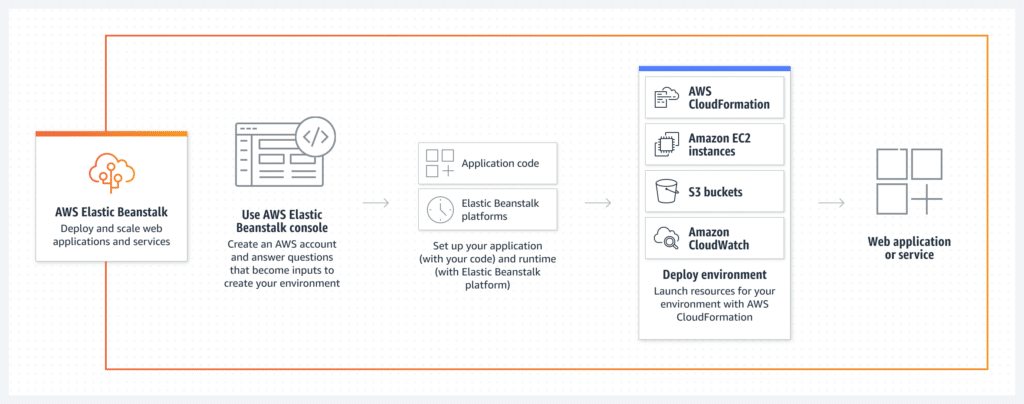AWS Elastic Beanstalk is a managed service offering from Amazon Web Services that simplifies the deployment and scaling of applications in the cloud. Automating server provisioning, load balancing, scaling, and monitoring frees developers from many infrastructure management tasks, allowing them to focus more on development rather than operations. This article delves into the advantages and disadvantages of using Elastic Beanstalk, helping potential users gauge its suitability for their projects.
Table of Contents
Overview of AWS Elastic Beanstalk
AWS Elastic Beanstalk supports several programming languages and development stacks, including Java, .NET, PHP, Node.js, Python, Ruby, Go, and Docker. By deploying applications on Elastic Beanstalk, users can leverage AWS services such as Amazon Simple Storage Service (S3), Amazon Simple Notification Service (SNS), and Amazon CloudWatch for storage, notifications, and monitoring, respectively. The service primarily targets developers looking for an easy-to-use environment for deploying web applications and services.

Pros of AWS Elastic Beanstalk
Easy Deployment
One of the standout benefits of AWS Elastic Beanstalk is its streamlined deployment process. Developers simply upload their application code, and Elastic Beanstalk automates every aspect of the deployment environment. This includes provisioning server capacity, setting up load balancing, and configuring auto-scaling. Such automation frees developers from the intricate details of infrastructure management, allowing them to focus primarily on their application development. This simplicity is especially beneficial for those who aim to reduce operational overhead and accelerate time to market.
Scalability
AWS Elastic Beanstalk excels in scalability. It automatically adjusts the compute resources based on the application’s demands, managing the number of Amazon EC2 instances required without manual intervention. This feature is crucial for applications that experience variable workloads and need to scale dynamically to maintain performance. For instance, during sudden traffic surges, Elastic Beanstalk can scale up resources to handle the increase and scale down when the demand drops, ensuring cost-efficiency and resource optimization.
Management and Maintenance
Elastic Beanstalk significantly reduces the burden of system administration. It automatically manages the patching of the operating system and updates the application stack (web servers, programming languages, etc.) to the latest versions. This managed service model ensures that the application environment is secure, stable, and up-to-date, which is vital for maintaining high availability and security standards. It allows developers to allocate more time to enhancing their applications instead of worrying about maintenance and upgrades.
Developer Productivity
Integration with development tools is another strong point of Elastic Beanstalk. It supports direct deployment from development environments like Git, Eclipse, and Visual Studio, which streamlines the development workflow. This integration helps in maintaining a smooth continuous integration and continuous deployment (CI/CD) pipeline, which is essential for modern software development practices. By reducing friction in the deployment process, developers can release updates and improvements faster, boosting overall productivity.
Cost-Effectiveness
Financially, Elastic Beanstalk is attractive as it eliminates the need for upfront investment in physical hardware or long-term commitments. Users pay only for the AWS resources (like EC2 instances and S3 storage) that are actually consumed by their applications. There are no extra costs for using the Elastic Beanstalk service itself, making it a financially viable option for startups and established businesses alike. This pricing model helps organizations keep their cloud computing costs predictable and aligned with their actual usage.
Together, these advantages make AWS Elastic Beanstalk an appealing platform for developers looking for an efficient, scalable, and cost-effective solution for web application deployment and management.
Cons of AWS Elastic Beanstalk
Limited Control
AWS Elastic Beanstalk offers a streamlined and simplified approach to deploying web applications on the AWS cloud. However, this ease of use comes with its own set of limitations, particularly in terms of control over the environment. Developers often find themselves facing constraints because Elastic Beanstalk automates many aspects of environment management, from server configuration and scaling to load balancing. This means that while developers can deploy applications quickly, they have reduced access to modify the underlying server and software configurations directly. This limited control can pose significant challenges for projects that require custom or finely tuned configurations to meet specific performance or security needs.
Complexity in Troubleshooting
The abstraction layer provided by Elastic Beanstalk, while reducing the need for direct infrastructure management, also obscures the visibility of the underlying components. This lack of transparency can complicate troubleshooting efforts when problems arise. Developers might find it difficult to pinpoint the source of an issue due to the limited access to the backend processes. Elastic Beanstalk provides log files and monitoring tools, but these might not offer the depth of detail needed for complex diagnostics, especially in multi-component architectures.
Vendor Lock-in
The convenience of using Elastic Beanstalk can also lead to vendor lock-in. Applications built on this platform are deeply integrated with AWS services and infrastructure. Migrating to another cloud provider often requires significant reconfiguration of the application to adapt to different service models or APIs. This dependency can limit flexibility and increase future migration costs or complexity.
Performance Overhead
While Elastic Beanstalk handles much of the resource management automatically, this convenience can come with a performance cost. The abstraction adds a layer of overhead that might not be present in a finely tuned, self-managed environment. For high-performance applications, even a small amount of additional latency or resource inefficiency can be impactful.
Suitability for Specific Applications
Elastic Beanstalk is designed to support standard web applications and services efficiently. However, it may not be the best fit for applications that require highly customized environments or have unique architectural demands. Developers working on such projects might find the service restrictive and unable to accommodate specific needs.
In summary, while AWS Elastic Beanstalk provides significant advantages in terms of deployment speed and scalability, it introduces challenges related to control, troubleshooting complexity, vendor lock-in, performance overhead, and suitability for particular application types. Understanding these limitations is crucial for organizations to make informed decisions about when and how to use this service effectively.
Conclusion
AWS Elastic Beanstalk offers significant advantages for developers looking to simplify their deployment processes and manage applications more efficiently in the cloud. Its benefits, such as ease of deployment, scalability, and cost-effectiveness, make it a compelling choice for a wide variety of projects. While it does present some challenges, like limited control and potential vendor lock-in, the overall value and efficiency it provides generally outweigh these issues. As AWS continues to enhance Elastic Beanstalk with more features and broader language support, it remains a relevant and attractive option in the evolving landscape of cloud computing. For developers and organizations seeking a balance between simplicity and powerful cloud capabilities, AWS Elastic Beanstalk proves to be an excellent tool.






